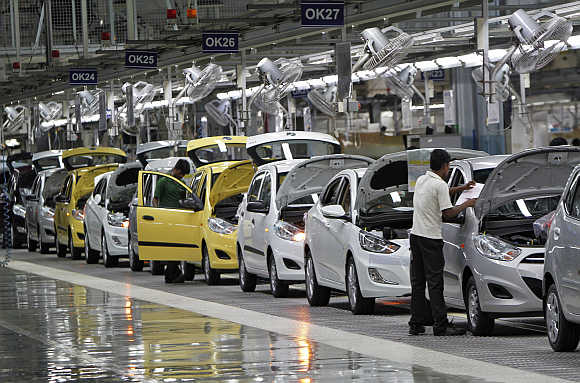 | « Back to article | Print this article |
India's slide to irrelevance
I had the opportunity to spend a week in the US, meeting a bunch of investors (both old India hands and potential new allocators), as well as attend a CIO (chief information officer) tour in India conducted by a leading global investment bank.
As far as the US investors were concerned, I detected tremendous scepticism towards India even now. The relentless barrage of negative publicity over the last 24 months will take time to overcome. India supporters have been shell-shocked as to how the country has let its image and reputation just implode.
Till two years ago, we were the next China, destined for a decade of nine to 10 per cent GDP (Gross Domestic Product) growth. Today, we are seen as a confused country, lurching towards populism, bordering on anarchy, which cannot execute and take the hard decisions needed to revive growth.
Our problems are largely self-inflicted, were mostly avoidable and have dimmed a strong structural growth story, which would have stood out in a growth-challenged world. Investors were not at all convinced that the last two months was the beginning of something fundamental or a turning point. Most thought that the finance minister got it, understood the issues and knew what to do, but doubted he could get the critical stuff done.
Click NEXT to read more...
India's slide to irrelevance
Nobody believed that genuine fiscal consolidation would happen. Yes, we may sell state-owned assets more aggressively (this year) to keep the fiscal deficit in check, but that would only kick the can down the road, and was not sustainable.
The prospects of the Goods and Services Tax getting adopted to boost revenues, a genuine reduction in subsidies to keep expenditure in control and cuts in tax exemptions were not deemed to be very high. In the absence of a concrete game plan, the fiscal deficit reduction targets (till 2016) outlined by the finance minister were seen as unrealistic. They were seen as statements and targets to pacify the Reserve Bank of India and get the rating agencies off his back, but unlikely to be achieved.
The investors I met just pointed to the fate of the previous FRBM (Fiscal Responsibility and Budget Management) targets. Basically, the government has a credibility problem vis-a-vis controlling the fiscal, and investors will only believe once measures have been implemented and the fiscal deficit reduced.
Nobody wants to be pre-emptive and give the government the benefit of the doubt. On improving the investment climate, most investors thought the NIB (national investment board) was already a non-starter, given the environment ministry's very public opposition.
Click NEXT to read more...
India's slide to irrelevance
Others did not quite understand how this new board would be different from an empowered group of ministers. Others pointed to the fact that the real delays are happening at the state and district level, and a NIB-type construct does nothing to address that. The lack of progress on a land acquisition Bill was also highlighted by some of the bears - even if you get approvals, what value are they without the ability to acquire land?
Some old India hands pointed to the chaos around mining of iron-ore. Given what has happened in Karnataka and Goa, and seems to be happening now in Odisha, who in their right mind will put up any new steel capacity, or any other raw material input-intensive capacity?
The power sector remains a shambles: without pooling of coal, it seems unlikely new capacity will come up. Many also felt that India has a structural inflation issue, and that markets were not cheap by any stretch of the imagination (especially when adjusted for inflation).
There was also tremendous fear and concern around the rupee. With a CAD (current account deficit) of nearly four per cent, on any risk-aversion, why could the rupee not go to 60 - an often heard refrain.
Click NEXT to read more...
India's slide to irrelevance
It goes without saying these were difficult conversations. I had thought investors would be in an upbeat mood given the reform thrust of the last 60 days, but found the exact opposite. Most investors were surprised by the 25 per cent up move in markets in the year to date - and many saw it as an opportunity to redeem and pull out, rather than add further capital to the country.
Given all the above, I continue to remain puzzled by the strong foreign inflows India has received. Around $18 billion received till date, and counting. Where is this money coming from? Who are these investors allocating more to the country? I obviously seem to be meeting the wrong people.
The other key takeaway was the growing irrelevance of the country. Many investors no longer believe they need an India strategy or specialist allocation. Investors still believe in having a dedicated China or Brazil allocation, but not India. The days of India being a separate asset class seem to be coming to an end.
Most investors thought the country was far too complicated and complex, and did not feel it worth the time and effort needed to really understand what is going on.
Click NEXT to read more...
India's slide to irrelevance
Many had redeemed out of India-specific allocations and moved back to regional products, or moved to India exchange-traded funds with very low costs and daily liquidity. There was also a general sense of disappointment with India managers and their ability to outperform the benchmark.
As another sign of the lack of interest: I just spent the entire day at a large Asia conference in Singapore, and India was not mentioned even once the whole day, a sad testimony to our relevance to global investors. Despite all the gloom and doom, I treat the above reaction as a positive. We may have hit a turning point in India and everybody is still cautious.
On the margin, things are improving, decisions are being taken; the quarter just completed was the first in the last six where earnings came in higher than consensus, growth is stabilising, yet nobody believes. Domestic investors are in full redemption mode - and, if my interactions are any indication, most of the smart global money is not yet buying into the India growth revival thesis.
India has gone through a painful two-year cycle of negative revisions to economic growth, earnings estimates and investor perception on the country. It is my bet that over the coming 12 months all three will turn.
Click NEXT to read more...
India's slide to irrelevance
In 2014-15, GDP and earnings growth will accelerate, interest rates will trend down and investors will realise the country is not all rotten. While valuations on headline numbers for the benchmark are not cheap, if you are willing to look beyond consumer names and some well-known domestic franchises, there are clear pockets of value.
If the Congress party can hold its nerve, and give the finance minister the political space and support to get some basic stuff done over the coming six months, the markets can have a very good 2013. If we as a country disappoint yet again, the slide towards irrelevance will be inexorable.
The writer is fund manager and CEO of Amansa Capital






